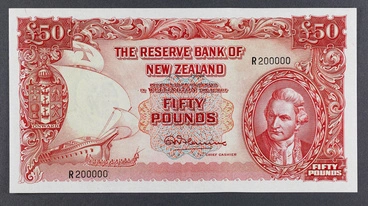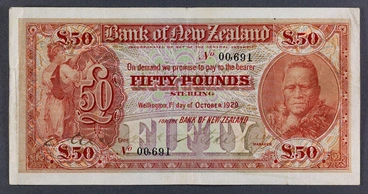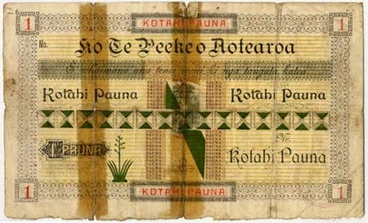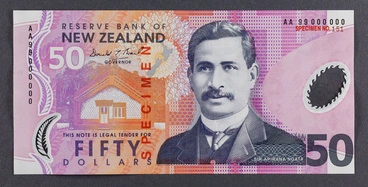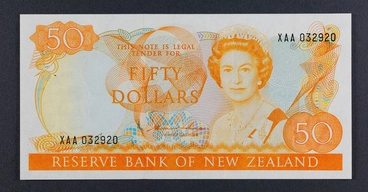A New Zealand 1951 fifty pound note
A DigitalNZ Story by National Library Services to Schools
This is a New Zealand 1951 fifty pound note.
These resources and text relate to the image of a New Zealand 1951 fifty pound note and the wider context of currency and its use of national identity imagery. They have been sourced and collated from DigitalNZ and other websites.
Reserve Bank of New Zealand 1940 Fifty Pounds Second Issue
Reserve Bank of New Zealand
Background
This is a Reserve Bank of New Zealand 1951 fifty pound note.
In New Zealand, paper money arrived with the Europeans. Prior to 1934, the six trading banks had produced the banknotes that were in common circulation. In 1924 the trading banks reached an agreement on a uniform design.
By the 1920s there was a general push to establish a central bank that would issue a single national currency. The decision was finally taken in 1930, and steps went ahead to set up the Reserve Bank in New Zealand with sole authority to issue New Zealand’s currency.
Work to design new banknotes began in 1932. They were finally issued in August 1934, six months after the Reserve Bank started.
The first banknotes were introduced in 1934. The second series was issued in 1940. The design and colours for the £50 note were changed. A portrait of Captain James Cook replaced that of King Tawhiao.
Māori banknotes
In 1886 the Māori King Tāwhiao established a bank, Te Peeke o Aotearoa, which was in business until around 1905. It was set up to provide banking and monetary services to Māori and was also an expression of Māori autonomy.
The bank produced banknotes, though none seem to have been officially issued. The few that survive are among the rarest notes in New Zealand. The surviving notes differ slightly and some have a truncated version of Tāwhiao's name – 'Tawhia' – in one corner.
Bank of New Zealand 1926 Fifty Pounds
Reserve Bank of New Zealand
Bank of Aotearoa One Pound Note, 1880s.
Reserve Bank of New Zealand
Reserve Bank of New Zealand 2000 Fifty Dollars Sixth Series
Reserve Bank of New Zealand
Context
Over the years designers have used many types of symbols on banknotes including flags, national coat of arms, and maps. But one of the most enduring symbols (also found on coins) have been portraits of monarchs, and heads of states. The first portrait on a banknote appeared in 1777 and they still remain popular — for example the portrait of Queen Elizabeth II appears on the New Zealand twenty dollar note.
Today, however, the scope of portraits has widened to include people who have reflected and contributed to a nation’s social, cultural and scientific history, like the side profile of Sir Edmund Hillary found on the New Zealand 5 dollar banknote.
New Zealand
Currency, like stamps, can be important expressions of a nation’s identity. Banknote designers can use symbols or other icons to underline important national ideas, beliefs, events, places and people. Typical examples are a coat of arms, the national flag, a geographic map or other national symbols like heraldic beasts, motifs relating to folklore and historical or symbolic places. In the case of the 1940 £50 note, Cook and his ship the Endeavour were used to symbolise the British ‘discovery’ of New Zealand.
Māori designs and motif were used quite often on 19th-century publications, especially tourist books. They also became common on trademarks and stamps. Designs with koru elements became an important, recognisable aspect of the branding of many public agencies over the course of the 20th century. The current $50 banknote incorporates a number of Māori design elements as well as a portrait of the Ngāti Porou and nationally significant politician, Apirana Ngata.
Example: New Zealand $10 note
Kate Sheppard appears on the New Zealand $10 note. The prominence given to her suggests New Zealanders' pride in being the first country in the world to grant women the vote, in 1893. Sheppard was a founding member of the Women's Christian Temperance Union in New Zealand. Through distributing pamphlets, organising meetings, writing letters to newspapers and extensive public speaking, she effectively led the fight for women's suffrage. In the left background of the note is a white camellia. These flowers were given to members of Parliament who supported the suffrage bill and have subsequently become a symbol of the fight for women's suffrage. In the Christchurch Botanical Gardens, there is a memorial walk to Sheppard which is lined with white camellias.
Fiona Barker, 'New Zealand identity - Politics', Te Ara - the Encyclopedia of New Zealand, http://www.TeAra.govt.nz/en/object/34611/kate-sheppard-on-the-10-note (accessed 3 August 2018)
Kate Sheppard on the $10 note
Manatū Taonga, the Ministry for Culture and Heritage
Reserve Bank of New Zealand 1981 Fifty Dollars Fourth Series
Reserve Bank of New Zealand
Stamps
Manatū Taonga, the Ministry for Culture and Heritage
Fertile questions
Why isn’t Captain Cook on our money today?
What are symbols and why do we use them?
Who would you put on Aotearoa New Zealand’s money?
What does money tell you about the place it comes from?
What is your question?
Quick facts
- If you had a perfect 1940 £50 banknote, it could be worth over $100,000 today.
- New Zealand's latest printed banknotes are called Series 7. They are more brightly coloured than previous banknotes. They also have advanced security features to stop counterfeiting or the making of illegal copies.
- The Series 7 features additional Māori language including Aotearoa - the Māori name for New Zealand and the names of native birds featured on the reverse of the banknotes.
- Our current ten dollar banknote commemorates suffrage by featuring Kate Sheppard and a white camellia. Kate Sheppard was New Zealand's most famous suffragette. The camellia flower became an important symbol in the fight to support the suffrage bill.
- Unlike the 50 pound note, New Zealand banknotes today are printed on a type of polypropylene plastic.
- It is illegal to write on New Zealand banknotes.
- The British monarch did not feature on New Zealand banknotes until 1967.
Millennial stamp
Manatū Taonga, the Ministry for Culture and Heritage
Centennial stamp
Manatū Taonga, the Ministry for Culture and Heritage
Other resources
1898 New Zealand pictorial stamps— some of the world’s earliest stamps that had pictures instead of portraits of leaders.
15 things more important than money— money is not the most important thing in life.
Brighter money — what’s different about our recent New Zealand banknotes?
Brighter money— ZM’s Georgia and Guy check out the $100 note.
New Zealand's first official banknotes — series 1 banknotes were first issued in 1934.
New Zealand identity — the symbols of Kiwi identity.
The history of banknotes in New Zealand— how New Zealand’s banknotes have evolved through history.
The World's coolest banknotes— discover some of the world's most interesting banknotes.
Street appeal symbols
Manatū Taonga, the Ministry for Culture and Heritage
Issued one penny 'Maori Art' Christchurch Exhibition stamp in claret
Museum of New Zealand Te Papa Tongarewa
Cook stamps
Manatū Taonga, the Ministry for Culture and Heritage
This story was compiled and curated by Te Puna Mātauranga o Aotearoa | National Library of New Zealand, Services to Schools staff, in 2019.
